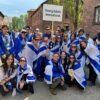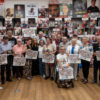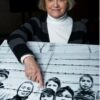-
‘If I Sleep for an Hour, 30 People Will Die’
The Forger: Video As a teenager, Adolfo Kaminsky saved thousands of lives by forging passports to help children flee the Nazis. He spent his life…
Continue reading -
Irena Sendler: The Holocaust heroine who saved 2500 Jewish children from Nazi evil
A VIDEO paying tribute to an astonishing nurse who “declared war on Hitler” and saved more than 2,500 Jewish children from the grasp of the evil Nazi regime has…
Continue reading -
French Holocaust survivor seeks honors for his Rosh Hashanah rescuers
Jacques Stuzalft teams up with local historian in bid to recognize French railway workers who saved dozens of children from Nazis on eve of Jewish New Year in…
Continue reading -
95-Year-Old Auschwitz Paramedic Charged in 3,681 Murders
A 95-year-old former paramedic at the Nazi death…
Continue reading -
Shimon Peres 1923-2016 ז״ל
The International March of the Living Board of Directors, Staff, Global Leadership…
Continue reading -
Video & Transcript: President Shimon Peres Message – 2016 March of the Living Latrun on Yom Ha’atsmaut
You already made the March of the Living. From the abyss of Jewish History, the Shoah, the lowest, most tragic point in our life,…
Continue reading -
March of the Living on The Shtick with Renny Rychter
Renny Richter, Co-President of March of the Living, tells us about the amazing experience of traveling to Poland and Israel in a group, dedicated to the Memory of the…
Continue reading



